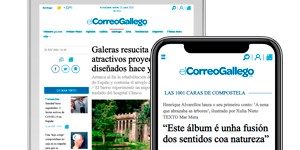ABC Newspaper
How to become a news company with state-of-the-art technology to able to deal with digital transformation
“We have achieved a single editorial system environment as an integration strategy, which also allows us to have an open solution for the development of new previously unviable business lines”




ABC, PRENSA ESPAÑOLA is the national newspaper with the longest pedigree in Spain. Founded on 1 January 1903, it has editorial assets that are unrivalled as a means of understanding the history of Spain in the twentieth century. But its longevity has not obstructed its ability to regenerate. It has always known how to change with the times. In the digital era, it has again shown its adaptability. The VOCENTO Group, its current owner, is probably the biggest press group in Spain, with leading newspapers throughout the country and it has been able to place the century-old newspaper on the frontline of technological change. Ángel Luis Ramírez, Infrastructure and Business Applications Manager, explains how this technological transformation has happened.
ABC has the newsroom structure which one would expect of a big national daily, with newsrooms in Madrid and Seville, and offices in Valencia, Catalonia, Castille-La Mancha, Castille-León, Aragon, the Canary Islands and Galicia. The analysis carried out by those in charge concluded that a large-scale technological change was necessary:
The rapid change in new technologies and consumer profiles made necessary significant changes to the chain of production and associated support systems to acquire the capacity to develop new computer products/services and manage them efficiently in order not to lose any audience and, in short, opportunity cost.
The new editorial system had to act as a spur to transform the corporate culture.
It was not enough to adapt the pre-existing internal systems by incorporating specific applications that cover specific needs and that respond to occasional new features on the market.
As a result, the implementation of a new editorial system could not be limited to just a change of editorial tool; it also had to be a complete change in the organisation’s approach to operating and production.
The main objective of the project was for ABC to have the necessary resources to become one of the most technologically pioneering companies in the editorial sector. The results of the project had to provide the solutions for the centralised management of the production processes from beginning to end. The goal was to achieve excellence in product optimisation, technological developments and the internal organisation of editing processes, and to increase the level of competitiveness, the quality and the audience.
To this end, 4 main courses of action were decided on:
Ensure that the newsroom was both autonomous and streamlined so that it could create, design and put on the page content.
Make available transversal operating and technical services, to achieve greater efficiency and operability.
Equip the archive with the appropriate resources for a multimedia newsroom. Prepare the system for the automatic cataloguing and future commercial exploitation of the archive.
Integrate the external newsroom to achieve the unification of workflows and favour multi-channel management and the publication of multi-format content.
Of fundamental importance was the creation of a multidisciplinary work team formed of systems engineers from Protecmedia and Vocento, as well as journalists and those responsible for all areas involved in the process of preparing and producing contents (advertising, pre-print, design, photography, archive...).
An exhaustive analysis-review was carried out of the production process from start to finish to establish the initial situation, locate bottlenecks and define new requirements. This analysis led to the following steps being taken:
Complete redefinition of the production process with respect to reception of contents, management of publications, graphic production and advertising, distribution of digital contents and sending to archive-documentary collection.
The user-friendly nature of the editing tool made the change easier for the newsroom, making it possible to focus every effort on the management of dummies and the production process (supervision and control of deadlines and changes of pages).
Establishment of an Implementation Plan covering the preparation of production environments, the training of the departments involved, the carrying out of performance-load tests and the start-up strategy for the different editorial products.
Plan the carrying out of the different tasks and the monitoring method.
Simultaneous start up in the MILENIUM and QUAY solutions.
Ángel Luis Ramírez summarises it as follows: “The implementation of this project offered the following: speed, versatility, management of new multimedia contents and less dependence on the technical area. All of the above while making it compatible with a single editorial system environment as an integration strategy, which also allowed us to have available an open solution for the development of new business lines that were previously unviable.”
The editorial process allows control of the production from start to finish. The newsroom is totally free to develop its products and all operating processes have been improved markedly, the bottlenecks that existed in the management of the use and handling of graphic and advertising material having been eliminated.
Automatic inclusion of ads in publications, with controls and verifications.
Autonomy of design and layout without any intervention of the technical area.
Editorial planning and global vision of the state of the publications in a single environment.
Knowledge of those in charge and those intervening of matters related to the origin of sources, validation of work, economic and legal factors, control, safety etc.
Improved content presentation and quality of reproduction. This is much better thanks to the inclusion of a production workflow standardised in PDF and a workflow for the automatic treatment of photographs.
Centralised entry of graphic contents and automatic adjustment to the media in which they will be published.
Integration of the digital and print newsrooms, from the organisational point of view, is now a reality and allows the documentary resources to be available for the production of off-line and on-line content.
The elimination of bottlenecks has led to a new distribution of the work and, above all, an improvement with respect to deadlines, which now solely depend on content, not technical matters.
aImprovement in “Time to Market”. Reduction of 1/3 of the time from when the publication is “designed” to when it is available.
Standardisation of the process for defining editions and designs. Elimination of specialist professional profiles for newspapers and supplements.
With respect to documentary resources (texts, photos and pages), the technological advance has been spectacular. The same archive includes present and historical content. Access to the sources of information has been greatly improved and the system has been equipped with tools that allow the creation of workflows, teamwork and the utilisation of contents for other uses, including the possibility of the commercial exploitation of the documentary resources.
Documentary Resources (1903 to 2013): 15 million documents, 3 million photos, 5.5. million articles, 6 million pages.










 )
)